Tuesday, January 4, 2011
1975-76 Buffalo Sabres Gerry Desjardins Jersey
Following the success of the 1972 Summit Series between Team Canada and the Soviet Union, more opportunities were sought for competition between teams of North American professionals and Soviet squads. The second such series took place in 1974, when a team of players representing the World Hockey Association, who were not allowed to participate in the 1972 version, faced off against the Soviet National Team.
Sabres GM Punch Imlach had a plan to deal with the Wings to take advantage of something the Sabres had that they did not, size on defense. Jocelyn Guevremont, Bill Hajt, Jerry Korab and Jim Schoenfeld were all at least 6' 2" and more than 200 pounds were all instructed to hit the Wings hard and as often as possible and outwork the Wings.
The concept was then expanded beyond the two-team exhibition series format with the introduction of the 1976 Canada Cup, a tournament format which featured national teams from six nations, who played a round robin format with the top two teams meeting in a best-of-three final.
Later in 1976, a new idea came to the fore, the "Super Series", in which the best two club teams from the Soviet League would travel to North America to play exhibition games against NHL member clubs, no doubt motivated by the opportunity to profit financially from the interest in seeing the exotic and still mysterious teams from behind the Iron Curtain.
Goal magazine program cover for the 1976 Super Series
The first of those games took place later in 1976 when both the famed Central Red Army (HC CSKA Moscow) and Soviet Wings (Krylya Sovetov Moscow) teams arrived in late December to play four games each against NHL competition. Such was the continued importance of beating the teams from North America from a propaganda standpoint, that both Soviet clubs also had the addition of a few of the better players from other Soviet clubs. Central Red Army was bolstered by a pair of skaters from Dynamo Moscow, while the Wings added four members of Spartak Moscow to increase their strength.
Central Red Army got things underway with a game on December 28, 1975 when they throttled the New York Rangers 7-3 at Madison Square Garden. The Soviet Wings tour began the very next day with similar results when they defeated the Pittsburgh Penguins 7-4.
Next up for the dominant club of Soviet club hockey, Central Red Army, was their famed battle with the Montreal Canadiens, a team on the verge of a dynasty of four straight Stanley Cups, on New Year's Eve in 1975, a 3-3 tie between two of the finest clubs ever in mid-season form, which is often called the greatest game of hockey ever played.
Next on the schedule, on this date in 1976, was the meeting between the Soviet Wings and the host Buffalo Sabres. The game was played at the Buffalo Memorial Auditorium in front of 16,433 fans.
Buffalo was one of the NHL's top teams at the time, having just competed in the Stanley Cup Finals at the conclusion of the previous season. They were led by "The French Connection" line of Gilbert Perreault, Rick Martin and Rene Robert. They, and the rest of the Sabres, were under pressure to win, as the NHL was still winless after the first three games.
The fans in Buffalo created an atmosphere that was simply electric as they sought to support not only their team, but the democratic way of life in the face of the communist system the Wings represented to them. "We came out onto the ice, and it had to be several minutes until it quieted down. We were so excited we could almost feel the ice shake," recalled Korab.
Krylya Sovetov Moscow
The four defensemen hit any and every puck carrier they could and Guevremont opened the scoring at 6:10 of the first period, which caused the Buffalo faithful to let out a thunderous roar. Exactly one minute later Perreault scored on Wings goaltender Alexander Sidelnikov to continue the celebration. Midway through the period Martin extended the Sabres lead to 3-0 but the Wings stemmed the tide when they scored a power play goal on the Sabres Gerry Desjardins at 13:45, but a little more than a half a minute later Martin struck again at 14:23. Sergei Kapustin closed out the period with a goal at 19:16 to keep the Wings within striking distance at 4-2 in favor of the Sabres. The period ended with the Sabres leading in shots on goal 17-9.
The second period was even more of a track meet as the Sabres extended their lead with a power play goal by Jim Lorentz at 4:32 followed by Robert a minute later at 5:32 to put Buffalo in a commanding 6-2 lead. The Wings' Vladimir Repnev kept the goals coming 27 seconds later to make the score 6-3. The teams again traded goals with Korab scoring on the power play at 8:26 and Victor Shalimov responding at 8:40. The seventh Sabres goal chased Sidelnikov from the Wings goal in favor of Alexsandr Kylikov. The Sabres then kept their foot on the gas when Danny Gare scored at 11:44 followed by Peter McNab, who made it 10-4 at 13:17 to continue the party in the stands as Kylikov's stay in the net ended after less than five minutes. The second period ended with the Sabres up 9-4 and now leading in shots 34-16.
The third period was more of the same as Kapustin got his second of the game for the Soviets at 3:28. Fred Stanfield added his name to the goal scoring roll call at 9:41 as the Sabres reached double digits followed by Yuri Lebedev for the Wings at 11:32.
The Sabres then hammered home their point when Gare scored at 14:04 and Brain Spencer finished off the worst loss ever by a Soviet team in international competition with his goal at 18:04 on another power play, the Sabres third of the game as they became the first NHL club to ever defeat a Soviet team. The final shots on goal for the evening were 46-25 in favor of Buffalo.
The scoreboard shows the final score of the Sabres historic victory
Martin was voted the games first star following his two goal, five point night. "You could tell they didn't like the fact they got out skated. When we were out on the ice, they all had this dumbfounded look on their faces. They didn't expect that. When we saw that would could skate with them, we just went for it and it worked," Martin said afterwards.
So popular was the Sabres win with NHL fans that they received a standing ovation before their next game - in Montreal!
Imlauch called the game "was the all-time high point for the Sabres"as well as the highlight of his lengthy career.
Such was the significance of the Sabres victory that a souvenir of a game is created following the contest
"I had never been so fired up for a game," said Martin. "I had played in a lot of big games, but that truly was the game I'll never forget."
The Wings rebounded from their crushing defeat by Buffalo to down the Chicago Black Hawks three days later 4-2 and conclude their North American foray with a 3-1 record after their 2-1 defeat of the New York Islanders.
Today's featured jersey is a 1975-76 Buffalo Sabres Gerry Desjardins jersey, the winning goaltender is the Sabres victory over the Soviet Wings.
The Sabres original jerseys had a lace up collar and no names on the back, which were later added by league mandated rules in 1977. You will notice however, that the Sabres did have names on the backs of their jerseys in the photo above, taken at the conclusion of the game against the Soviet Wings.
Popular belief among team owners at the time was that names on the back would result in less sales of game programs, but common practice at the time was to add names for games that were nationally televised and this may have been the case for the game against the Wings, either for American audiences or perhaps even possible viewers back in Russia. The font used for the names does have serifs on the letters, while the standard font for names on the backs of Sabres jerseys beginning in 1977 was a simpler block font without serifs.
The Sabres jerseys retained their lace up collars until 1978-79 when they were replaced by v-neck sweaters.
Desjardins began his NHL career with the Los Angeles Kings in 1968-69 and was later involved in a trade which sent him to the Chicago Black Hawks in 1969-70. Chicago actually traded him to the California Seals on September 9th, 1971, only to be sent back to Chicago in another trade five weeks later before ever playing a game for California!
The New York Islanders claimed him in the 1972 expansion draft from Chicago. He suffered through two losing seasons as the Islanders found their feet in the NHL. Desjardins sought greener pastures in the WHA, but signed for the 1974-75 season with the unstable Michigan Stags franchise, which became the Baltimore Blades mid-season, a move which triggered an escape clause in his contract, allowing him to sign with the Buffalo Sabres in time to appear in nine regular season games as well as the teams playoff run all the way to the Stanley Cup Finals.
With Buffalo, he found not only stability, but success as well, easily setting career highs with 29 and then 31 wins as the Sabres number one goaltender before being forced to retire after being struck in the eye by a puck after playing just three games of the 1977-78 season.
Bonus Jersey: Today's bonus jersey is a 1975-76 Soviet Wings Alexander Yakushev jersey as worn by the Wings during the Super Series '76 when Yakushev was loaned by Spartak Moscow to the Wings for their series of games against the NHL, including the Sabres resounding victory over the Wings.
The "KC" initials on the front translate to "KS", standing for Krilya Sovetov, which in turn translates to "Wings of the Soviet". The cresting is done in felt on the wool sweater, while the nameplate has twill letters in English on nylon, which was added for the North American TV audiences.
Our video section today begins with the introductions of the conquering heroes, the Buffalo Sabres.
Pull up a chair and get comfortable, here are extended highlights of the goals from the Sabres win over the Soviet Wings, the first win for an NHL club over a Soviet team.
Subscribe to:
Post Comments (Atom)

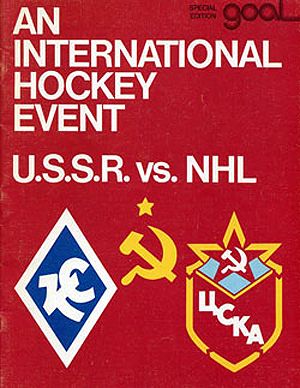
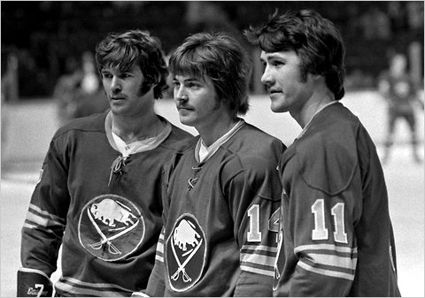
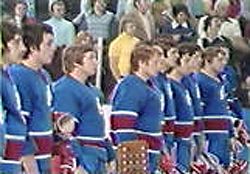
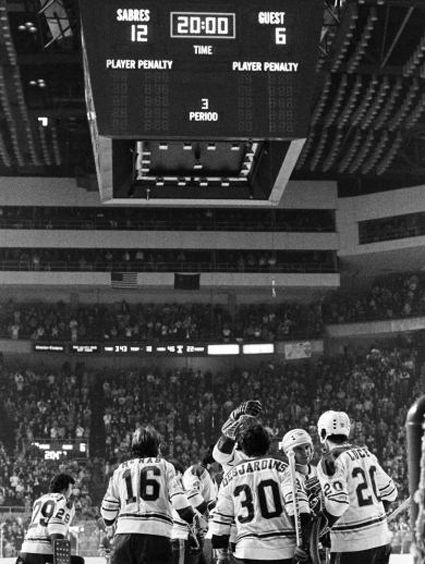


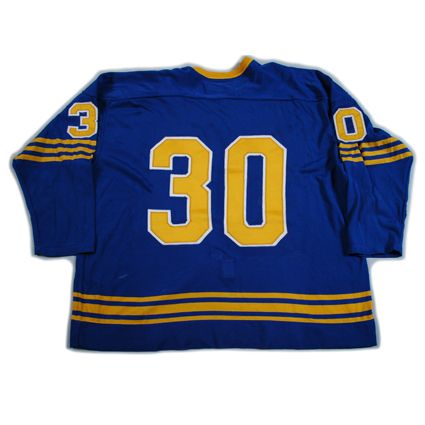
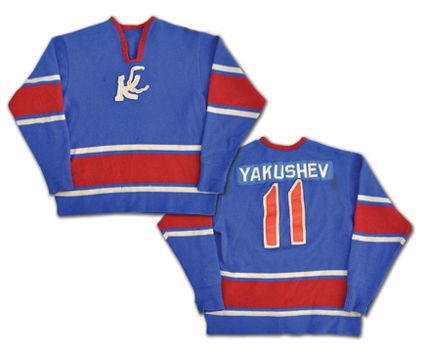










Desjardins was hurt in the later part of the 76-77 season. It caused the "Al Smith incident" where he quit the team during the anthem.
ReplyDeletethe 3 games in 77-78 were attempts to come back that didn't work out